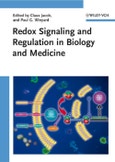This first entry-level guide to the multifaceted field takes readers one step further than existing textbooks. In an easily accessible manner, the authors integrate the biochemistry, cell biology and medical implications of intracellular redox processes, demonstrating that complex science can be presented in a clear and almost entertaining way.
Perfect for students and junior researchers, this is an equally valuable addition to courses in biochemistry, molecular biology, cell biology, and human physiology.
Perfect for students and junior researchers, this is an equally valuable addition to courses in biochemistry, molecular biology, cell biology, and human physiology.
Table of Contents
IntroductionBiological Systems Relevant for Redox Signaling and Control
Cellular Generation of Oxidants: Relation to Oxidative Stress
The Chemical Basis of Biological Redox Control
Protein Glutathiolation
Structure and Function of the Human Peroxiredoxin-Based Antioxidant System: the Interplay between Peroxiredoxins, Thioredoxins, Thioredoxin Reductases, Sulfiredoxins and Sestrins
Hydrogen Peroxide and Cysteine Protein Signaling Pathways
Protein Tyrosine Phosphatases as Mediators of Redox Signaling
Hypoxia-Induced Gene Regulation through Hypoxia Inducible Factor-1a
Eicosanoid-Based Signaling
Redox-Controlled Transcription Factors and Gene Expression
Nitric Oxide Regulation in Redox Signaling
Is Hydrogen Sulfide a Regulator of Nitric Oxide Bioavailability in the Vasculature?
Aspects of Nox/Duox Signaling
Photodynamic Therapy with Aminolevulinic Acid and Iron Chelators: A Clinical Example of Redox Signaling
Oxidative Stress and Apoptosis
Redox Regulation of Apoptosis in Immune Cells
Redox Control in Human Disease with a Special Emphasis on the Peroxiredoxin-Based Antioxidant System
Free Radicals and Mammalian Aging








